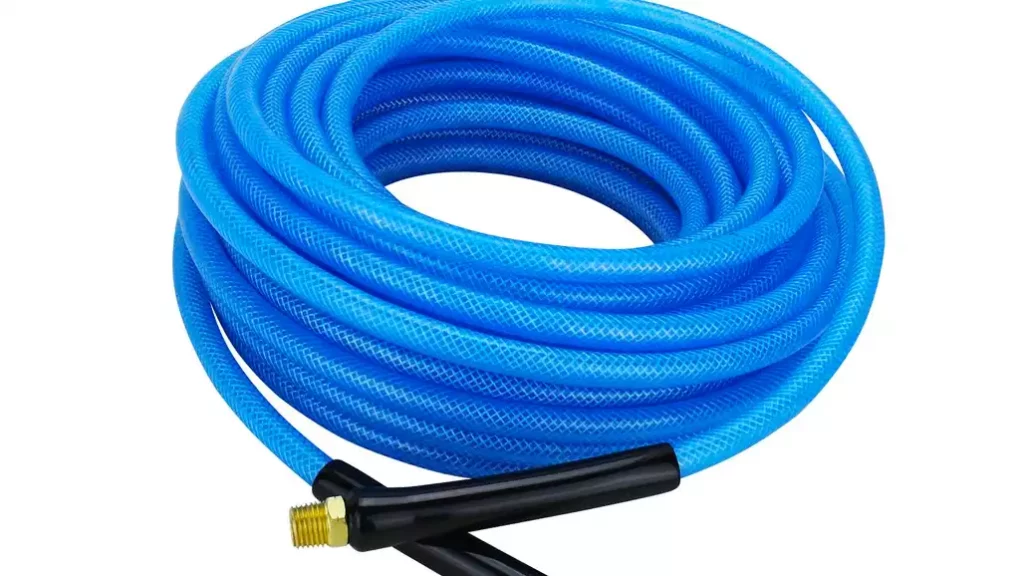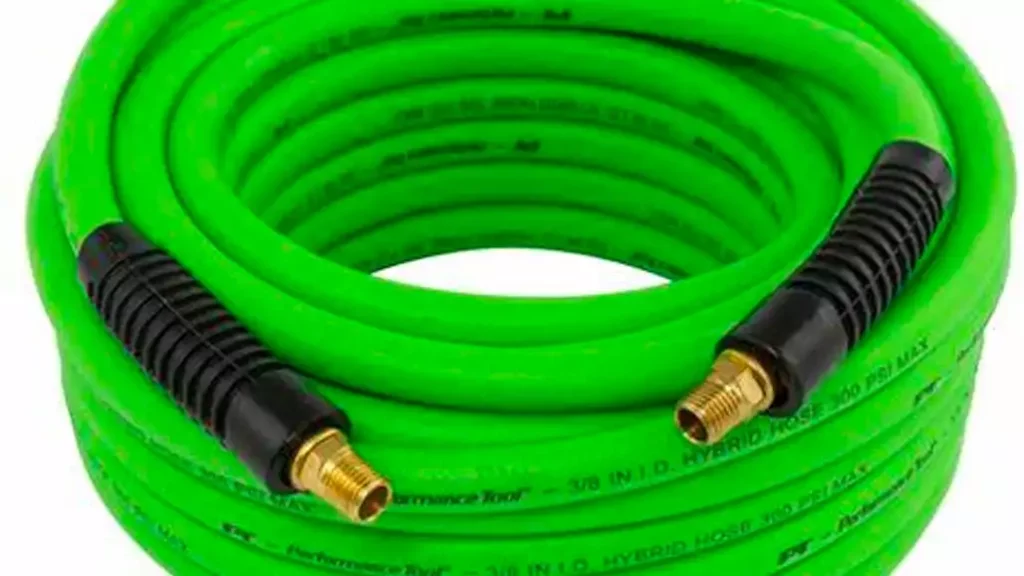Looking to purchase an air hose, but not sure whether to choose polyurethane or PVC? This comprehensive comparison will help you make an informed decision by exploring the pros and cons of each material, its durability, and flexibility, resistance to abrasion and kinks, chemical resistance, and overall performance.
Read on to find out which type of air hose is right for your needs.
Air hoses are crucial in many industries, such as automotive, construction, and manufacturing. They are responsible for carrying air from the compressor to the tool or equipment, making them essential components in any job site. However, not all air hoses are created equal. Two of the most popular materials used for air hoses are polyurethane and PVC. In this article, we’ll compare polyurethane vs PVC air hose and determine which one is the better option.
What Is Polyurethane Air Hose?

Polyurethane air hose is a type of thermoplastic elastomer that is known for its excellent flexibility, durability, and kink-resistance. It is also resistant to abrasion, punctures, and chemicals, making it a popular choice for various industrial applications.
Properties of Polyurethane Air Hose
- Highly flexible
- Durable
- Kink-resistant
- Abrasion-resistant
- Chemical-resistant
- Temperature-resistant (-40°F to 165°F)
What Is PVC Air Hose?

PVC air hose, on the other hand, is a type of plastic polymer that is widely used for various industrial applications. It is known for its low cost, lightweight, and ease of use. However, PVC air hoses are not as durable or flexible as their polyurethane counterparts.
Properties of PVC Air Hose
- Low cost
- Lightweight
- Easy to use
- Limited flexibility
- Susceptible to kinks
- Limited abrasion resistance
- Temperature-resistant (-10°F to 150°F)
Polyurethane vs PVC Air Hose Comparison

When comparing polyurethane vs PVC air hose, several factors must be considered. These include durability, flexibility, kink resistance, abrasion resistance, chemical resistance, and temperature resistance.
Durability
Polyurethane air hose is more durable than PVC air hose. It is resistant to punctures, abrasion, and chemicals, making it suitable for rugged industrial applications. PVC air hoses, on the other hand, are more prone to kinking, cracking, and punctures, making them less durable in harsh conditions.
Flexibility
Polyurethane air hose is highly flexible, making it easy to maneuver in tight spaces. It also retains its shape even when bent, making it an ideal choice for applications that require constant movement. PVC air hoses, on the other hand, are less flexible and prone to kinking, making them more challenging to use in tight spaces.
Kink Resistance
Polyurethane air hose is kink-resistant, making it suitable for applications that require constant movement or twisting. PVC air hoses, on the other hand, are prone to kinking, making them less suitable for these types of applications.
Abrasion Resistance
Polyurethane air hose is highly abrasion-resistant, making it suitable for applications that involve dragging or pulling. PVC air hoses are less abrasion-resistant, making them more prone to wear and tear in harsh conditions.
Chemical Resistance
Polyurethane air hose is more chemical-resistant than PVC air hose. It can withstand exposure to various chemicals and oils without degrading. PVC air hoses, on the other hand, are less chemical-resistant and can degrade when exposed to certain chemicals.
Temperature Resistance
Polyurethane air hose has a broader temperature range than PVC air hose. It can withstand temperatures as low as -40°F and as high as 165°F. PVC air hoses are limited to temperatures between
-10°F and 150°F, making them less suitable for extreme temperature conditions.
Price
One of the significant differences between polyurethane and PVC air hoses is their price. PVC air hoses are more affordable than polyurethane air hoses, making them a popular choice for those on a budget.
Which One Is better?
Here’s a table comparing PVC and polyurethane hoses:
| Property | PVC Hose | Polyurethane Hose |
|---|---|---|
| Material | Polyvinyl Chloride (PVC) | Polyurethane (PU) |
| Durability | Less durable than polyurethane | More durable than PVC |
| Flexibility | More rigid than polyurethane | More flexible than PVC |
| Kink Resistance | More likely to kink than polyurethane | Resistant to kinking |
| Temperature Range | Typically has a lower temperature range than polyurethane | Can withstand higher temperatures than PVC |
| Chemical Resistance | Resistant to some chemicals, but not as much as polyurethane | Resistant to many chemicals and solvents |
| UV Resistance | Less resistant to UV than polyurethane | More resistant to UV than PVC |
| Abrasion Resistance | Lower than polyurethane | Higher than PVC |
| Cost | Typically less expensive than polyurethane | Typically more expensive than PVC |
In summary, PVC hoses are generally less durable, less flexible, and have lower chemical and UV resistance than polyurethane hoses. However, they are typically more affordable. Polyurethane hoses, on the other hand, are more durable, flexible, and resistant to chemicals and UV rays, but are also more expensive than PVC hoses.
When it comes to choosing between polyurethane and PVC air hoses, it ultimately depends on your specific needs and applications. If you need an air hose that is highly flexible, durable, kink-resistant, abrasion-resistant, and chemical-resistant, then polyurethane air hose is the better option. However, if you’re on a tight budget and need a basic air hose for light-duty applications, then PVC air hose can be a suitable choice.
Pvc vs Rubber vs Polyurethane Air Hose

PVC, rubber, and polyurethane are three common materials used for air hoses, and each has its advantages and disadvantages.
PVC air hoses are lightweight, flexible, and inexpensive. They are typically used in low to medium pressure applications and are suitable for use in temperatures ranging from 0 to 140 degrees Fahrenheit (-18 to 60 degrees Celsius). However, PVC hoses are prone to kinking and can become brittle over time, especially in colder temperatures.
Rubber air hoses are more durable than PVC hoses and are resistant to kinking and abrasion. They can also withstand higher temperatures, typically up to 212 degrees Fahrenheit (100 degrees Celsius). However, rubber hoses are heavier and less flexible than PVC hoses, which can make them more difficult to maneuver in tight spaces.
Polyurethane air hoses are lightweight and highly flexible, making them easy to handle and ideal for use in tight spaces. They are also resistant to kinking and abrasion, and can withstand a wider temperature range, typically from -40 to 165 degrees Fahrenheit (-40 to 74 degrees Celsius). However, polyurethane hoses are more expensive than PVC or rubber hoses.
| Material | PVC | Rubber | Polyurethane |
|---|---|---|---|
| Weight | Lightweight | Heavy | Lightweight |
| Flexibility | Highly flexible | Less flexible than PVC | Highly flexible |
| Cost | Inexpensive | Moderate | Expensive |
| Kink Resistance | Prone to kinking | Resistant to kinking | Resistant to kinking |
| Abrasion Resistance | Poor | Good | Good |
| Temperature Range | 0 to 140°F (-18 to 60°C) | Up to 212°F (100°C) | -40 to 165°F (-40 to 74°C) |
| Durability | Moderate | High | High |
| Best for | Low-pressure applications, cost-effective | Demanding applications, abrasion resistance | Applications requiring flexibility, durability, and wide temperature range |
The choice of air hose material depends on the specific needs of the application. PVC hoses are a good choice for low-pressure applications where cost is a factor, while rubber hoses are better suited for more demanding applications where durability and resistance to abrasion are important. Polyurethane hoses are ideal for applications that require a combination of flexibility, durability, and a wide temperature range.
Here is a table summarizing the main characteristics of PVC, rubber, and polyurethane air hoses:
| Material | PVC | Rubber | Polyurethane |
|---|---|---|---|
| Cost | Inexpensive | Moderate | Expensive |
| Weight | Lightweight | Heavy | Lightweight |
| Flexibility | Highly flexible | Less flexible than PVC | Highly flexible |
| Kink Resistance | Prone to kinking | Resistant to kinking | Resistant to kinking |
| Abrasion Resistance | Poor | Good | Good |
| Temperature Range | 0 to 140°F (-18 to 60°C) | Up to 212°F (100°C) | -40 to 165°F (-40 to 74°C) |
| Durability | Moderate | High | High |
Keep in mind that these are general characteristics and specific product variations may have different properties. It’s important to choose the right material for your specific application based on the operating conditions and requirements.
Conclusion
In conclusion, both polyurethane and PVC air hoses have their unique strengths and weaknesses. While polyurethane air hose is more durable, flexible, and chemical-resistant, PVC air hose is more affordable and lightweight. When selecting the right air hose for your application, consider the factors mentioned above and choose the one that best suits your needs.




